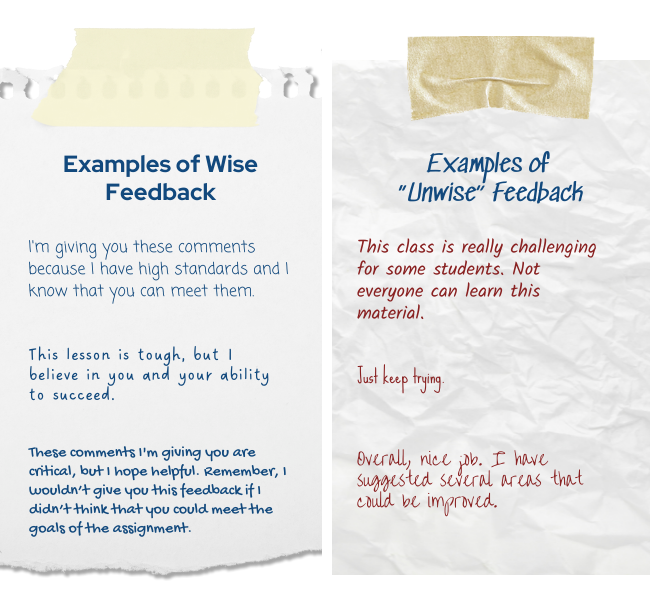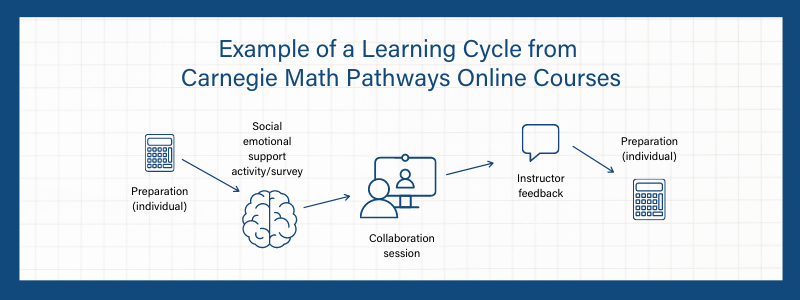Evidence shows that building students’ sense of belonging in the classroom is crucial to their success, particularly in math, one of the most feared and maligned subjects. These anxieties and negative outlooks on math can be exacerbated in online courses, where students can feel even less connected to the instructor and their classmates as they learn at a distance.
In our latest Quality Instruction webinar, we discussed the supports and interventions that the Pathways community has found to be effective in fostering students’ sense of belonging, and how these have been adapted online to support learners from the beginning of the term, right to the end. Below, we offer some of the practical strategies you can use to build up your students’ sense of belonging in online courses and help them feel ready to succeed.
Jump to section
Provide a welcome package
Promote a growth mindset
Provide wise feedback
Share emotion regulation and metacognitive learning strategies
Provide a welcome package
The start of the term can set the tone for the rest of the course, and thoughtfully considering how you’ll first engage students in your course is critical to establishing a welcoming learning environment. In Pathways courses, we think of the elements that support student belonging at the start of each course as being part of a package—what we call “Starting Strong.” This package supports students in the first weeks of the course to develop the mindset and skills needed to succeed in a college course. The following are key elements of a course welcome package that we’ve found most impactful for creating an inclusive and connected online learning community.
A clear, intuitive course landing page. The course landing page presents an opportunity to clearly establish expectations and lay foundations on which to build community and belonging with and among your students. On this page, we suggest including a welcome video to introduce yourself and the course to your students; activities such as a syllabus scavenger hunt to orient students to the platform and a “get to know you” activity in which students can meet one another; and clear next steps on how to begin the course.
Predictable and visible course structure. A “learning cycle” describes learning as happening in phases, where students improve their skills by engaging in a predictable, and repeatable cycle of learning activities. In Pathways courses, students follow the same learning cycle in every unit of each module, establishing a predictable pattern that enables them to focus their energy on the content and working with their peers rather than on navigating the course structure. By mapping the learning cycle and representing it visually in your courseware, you can make the course environment familiar for students, which can contribute to their continued engagement.
Course orientation. Instructor-led orientation sessions scheduled during Week 1 of your courses provide a chance to talk through course expectations and give students another opportunity to be visible in the learning space, ask questions, and strengthen connections with you, their peers, and the key course processes.
Investing in these early measures to welcome students and create an inclusive learning community sets the stage to help students productively engage throughout the course and feel like they belong.
Promote a growth mindset
Beyond Starting Strong, or the course welcome package, Pathways courses implement Staying Strong, a package of resources and interventions to help students maintain their confidence and motivation beyond the first weeks to successfully complete the course. An important component to ensuring students “stay strong” is an emphasis on growth mindset.
A growth mindset describes the belief that one is capable of learning a given subject and even excelling at it. Because students who have previously struggled with math tend to believe they can’t master the content, it’s important to show them evidence to the contrary and instill a growth mindset*—especially in online courses where students spend less time with the instructor, who can provide encouragement. One way we do this in Pathways courses is by sharing an article with students that describes the malleability of the brain, even in adulthood, and that individuals can improve their abilities in anything as long as they practice and use good learning strategies. Students have reported experiencing a newfound outlook on their ability to do math after reading the article.
Provide wise feedback
Another important factor to helping students persist in the course is ongoing, constructive feedback. Because online courses are more limited in their face-to-face interactions, the feedback given to students carries even more weight. Consequently, we must be mindful that our well-intentioned feedback does not inadvertently convey low expectations for our students. In Pathways courses, we promote “wise” feedback, which consists of phrases that communicate that the class has a high standard and that you believe that the student is capable of meeting that standard. By communicating to students that they’re capable of excelling in a rigorous course, wise feedback fortifies for students the belief that they can achieve and do belong in your course.

Share emotion regulation and metacognitive learning strategies
Students’ sense of belonging in online classes is also strongly influenced by how they respond to everyday learning activities of the course, and how comfortable they feel engaging with them. Learning in an online environment can present new challenges to students and we can support them by proactively discussing strategies to learn in an online setting.
The first set of strategies we introduce in Pathways courses is emotion regulation strategies to respond to stress in a healthy way. Engaging with rigorous material can be frustrating at times and may even heighten existing levels of anxiety if the student believes that stress is a sign of impending failure. In our Stress Reappraisal intervention, we share research with students that shows that the physiological signs of stress are also signs that you are preparing to take on a challenge, as opposed to running from one. Engaging in this reading and writing activity, relative to a similar control article, significantly boosted students’ performance on exams. By presenting information to your students about how stress works and how they can regulate it, you can help them discover healthy ways of managing it that benefit them throughout the course and beyond.
The second set of strategies focuses on developing metacognitive awareness. Metacognition refers to how students are thinking about their thinking. Being able to identify and then address gaps in their learning can bolster a student’s confidence and identity as a learner. We have integrated self-regulation prompts in all online assignments as well as before synchronous collaboration sessions that challenge students to assess their confidence with specific math concepts.
Recap
As more students seek to carry out their education online, it’s incumbent upon us to move beyond the message board or comments section to engage them in meaningful online learning that welcomes them and makes them feel they have a place in class. By fostering students’ sense of belonging with strategies such as these, we can move toward online courses that build a stronger sense of community and lead to greater student success.
To learn more about other ways Carnegie Math Pathways online courses engage students, read our learning brief Narrowing the Distance in ‘Distance Learning’: Lessons from Carnegie Math Pathways on Designing for Student Success Online. And be sure to sign up for our monthly newsletter, In Sum, to stay informed about additional research and learning from Carnegie Math Pathways.
*It’s important to note that promoting a growth mindset does not imply that students can succeed just by changing their beliefs. Much more factors into their success, including quality of instruction. We recommend exploring the research of Carol Dweck, the originator of the growth mindset framework, for further learning in this area.

